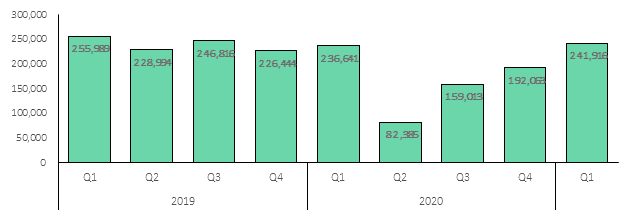 By Legal Futures Associate Search Acumen [1]
By Legal Futures Associate Search Acumen [1]
- Q1 2021 transactions were up 193% on Q2 2020 after the shutting down of the property market caused transactions to slide to 82,385
- Strong trading conditions have led to a sustained recovery in the number of active conveyancing firms – active firms climbed 4% to 3,962 in Q1 2021, up from 3,808 in Q4 2020
- Number of transactions completed by the average firm rose 21% over the last quarter to 61, underlining the scale of orders conveyancing firms are having to cope with
The number of property transactions registered in England and Wales climbed 26% over the last quarter, rising to 241,916 in Q1 2021, up from 192,063 in Q4 2020, according to the latest edition of the Conveyancing Market Tracker from Search Acumen, the property data insight and technology provider.
This is the first time quarterly transactions have topped to pre-pandemic levels since the onset of Covid.
The tracker shows conveyancing volumes reached 241,916 in Q1 2021, up 2% from 236,641 in Q1 2020. This is the first time quarterly transactions have reached these levels since before the onset of Covid-19. Q1 2021 transaction volumes were almost double (up 193%) those recorded in Q2 2020 after the shutting down of the property market caused transactions to slide to just 82,385.
Surging property transactions since the first lockdown can be partly attributed to the Stamp Duty Land Tax (SDLT) holiday, introduced in July 2020. This has triggered a wave of home purchases as buyers rush to capture the financial benefits on offer.
Search Acumen’s analysis shows January 2021 represented the busiest month of the quarter, with 86,130 transactions occurring, the highest monthly total since November 2019. There was a slight dip in February 2021 to 76,239 transactions, likely resulting from uncertainty over whether the SDLT holiday would be extended beyond March, as well as the impact of the return of lockdown conditions over Christmas and January.
Graph 1: Number of quarterly transactions since Q1 2019

Number of Active conveyancing firms continues to climb from 2020 lows
The tracker shows high activity levels in the market have contributed to a sustained recovery in the number of active conveyancing firms. Active firms climbed 4% over the last quarter to 3,962 in Q1 2021, up from 3,808 in the previous quarter.
Stronger trading conditions have helped to push the number of active conveyancing firms above pre-pandemic levels for the first time, with levels now exceeding the 3,928 firms in operation in Q1 2020 and the 3,920 who were active in Q4 2019. Comparisons to Q2 2020 illustrate the pace of the market’s recovery, where there were just 2,411 firms active. Q1 2021 figures represent a 64% increase from the heights of the pandemic.
The number of transactions completed by the average firm rose 21% over the last quarter to 61 per month, underlining the scale of orders conveyancing firms are having to process amid strong demand in the property market. This is a considerable jump from when the pandemic took hold in Q2 2020, which saw average caseloads drop to just 34 per month. Since then, average transactions have increased, with Q1 2021 representing the pinnacle of activity being handled by conveyancers since the pandemic began.
Graph 2: Number of active conveyancing firms since Q1 2019

Andy Sommerville, Director at Search Acumen said: “This data indicates that the growth of the property market shows no signs of slowing down. Government stimulus measures, compounded by cheap mortgages and stronger demand for larger properties that provide more green space and opportunities to work from home more comfortably, are the key factors behind the bounce-back in transactions.
“Conveyancers have been running hot to help get clients’ transactions over the line since the Stamp Duty holiday was first announced. Our analysis suggests that the cost of protecting the property market has had intense pressures on real estate lawyers. Higher average transaction volumes illustrate the growing workload conveyancers are having to shoulder, which has put a huge strain on their wellbeing and productivity.
“The extension of the Stamp Duty holiday is likely to have a more muted impact on demand in the property market in the medium term. Since a large proportion of activity has been driven by buyers who have relatively higher amounts of housing equity and are now likely to have completed transactions, the pool of prospective buyers in the market has shrunk, which will put downward pressure on demand.”
“Despite this, lawyers have a huge task ahead of them to clear the backlog of transactions that have piled up and help homebuyers achieve their dreams before the window shuts. While many firms have embraced digital ways of working to manage during Covid-19 restrictions, we urge the sector to prioritise a digital-first approach as we look to the future. Through modest investment in digital solutions and training to upskill workers to improve their technological proficiency, firms can capture productivity gains and deliver a more efficient service to clients. These workflow improvements will make the transaction process far more seamless; help get people into homes quicker and make the sector more resilient to future shocks.”